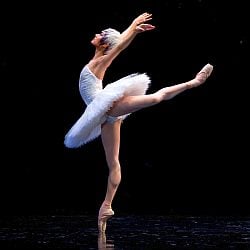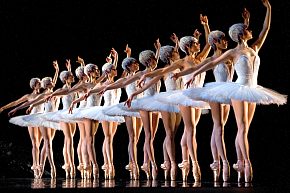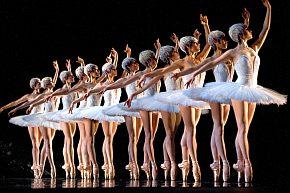Ballet aspires to the otherworldly. The dancer on the tips of her toes seems freed from the constraints of gravity: able to spin unrestrainedly, to move like quicksilver or a cloud. The ballerina’s partner helps her escape the earth’s physical confinements, allowing her to take flight. The male dancer’s great leaps seem to suspend him in midair.

as Odette
Photos by Erik Tommason
In the story-telling world of the 19th century, ballets inhabited the realms of fairy tale and myth, and of those ballets Swan Lake was — and remains — the most ethereal, the most transcendent.
Odette, danced by the principal ballerina, is suspended between being human and being a swan, confined by a sorcerer whose evil is inexplicable and, as such, supernatural in its own right. She is enthralled to the world of air. Her lover, her prince, is equally enthralled to the earth. Much of the ballet’s music and dance is given over to Prince Siegfreid’s court and his need to choose a bride, to fulfill his social obligations of lineage. The only avenue to the lovers’ fulfillment leads through their mutual death, in which they are changed, finally, into swans — inhabitants of the heavens.
The story of lovers transformed into water birds is so ancient that it’s impossible to pin down its prehistoric origins; it’s deeply wound into Russian, European, and Greek mythologies. Thus the idea of “updating” the ballet is a curious one. But for the most part — and despite San Francisco Ballet’s huge media push touting the new production as a world premiere — Artistic Director and Choreographer Helgi Tomasson’s Swan Lake is an essentially conservative re-vision.
And that is all to the good. Why mess with a winning combination?
With rich and varied costuming, elegantly designed sets, and a touch of visual effects (unobtrusively provided by video), the new production is a model of artistic restraint and taste. London-based designer Jonathan Fensom, who kept the costumes in early 19th-century period, preserved the emotional sense of the ballet’s heart-indwelling metaphors: the full moon that hangs above the rocky landscape of the second act reappears central to the third act’s palace ballroom, flanked by curving stairways that lead upward into blackness. Video designer Sven Ortel devised a watery projection over sheer curtains, which became the moving barriers between the natural and supernatural worlds, and also created the swans’ silhouettes that winged across the color-rich skies of Jennifer Tipton’s skillful lighting.
Clarity of Balletic Gesture
Tomasson’s changes in the choreography are likewise thoughtful. The addition of a prologue during the overture explains the transformation of Odette into a swan, when, rising from a stone bench, the evil Von Rothbart, gothed to the max, slithers his way toward the young Odette and, failing to seduce her, enchants her, robbing her of her humanity. Because of its clarity and cleanness of gesture, Tomasson’s choreography is well-suited to this story of “long ago and far away.”
The portrayal of Von Rothbart as an elemental force is one of the production’s strongest features. By the lake and under the full moon, this black-clad courtier gone bad becomes an eerie, feather-bedecked creature, his movements stuttering and strangely animal. Damian Smith was startling and effective in his interpretation.

The heart of the ballet, however, lies in the ballerina who dances Odette and her evil twin, Odile. There are no fewer than six casts of soloists for the ballet’s nine performances, but Yuan Yuan Tan was the opening night choice for this coveted part. Blessed with a delicate bone structure, deft lines, theatrical sensitivity, and a back of superlative flexibility and strength — goddess! her back puts the serpentine grace of a swan’s neck to shame — she embodied a woman covered in the melancholy plumage of an enchantment that both separates and imprisons her. As Odile, Von Rothbart’s daughter sent to deceive the prince and draw his love away from Odette, Tan was an insistent and fiery seductress.
It was the movement of her arms, though, that epitomized Odette’s liminal state between human and bird. As they moved flawlessly between the angular and fluid, Tan’s finely boned arms suggested not only the grace of wings in flight but also the necessity of pattern that flying exacts. To stay aloft, the flyer is confined, albeit beautifully, to set movement. The rippling pattern became a motif for Odette’s despair.
Tiit Helimets danced Prince Siegfried. He was a solid partner and a graceful aristocrat. Still, the part itself lacks both interesting choreography and engaging theater. As my son Emmanuel put it: “Princes have their hair cut at Super Cuts; evil guys get their hair styled at Vidal Sassoon’s.”
One thing that could not be changed (though perhaps could be rearranged) is Tchaikovsky’s music. It’s not hard to imagine that this story of impossible love intersected with some deep, unfulfilled yearning within the composer. Swan Lake contains some of his most plaintive and electrically beautiful melodies. Those moments where the ballet and story most affect the heart are those composed of exquisitely poignant music. Martin West led the San Francisco Ballet Orchestra, with Roy Malan playing the tender violin solo that interlaces the lovers’ pas de deux.

